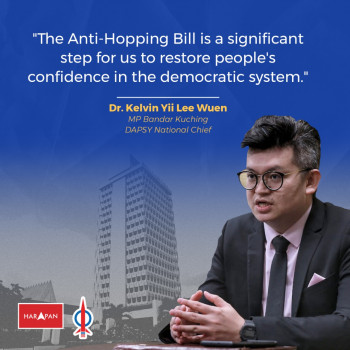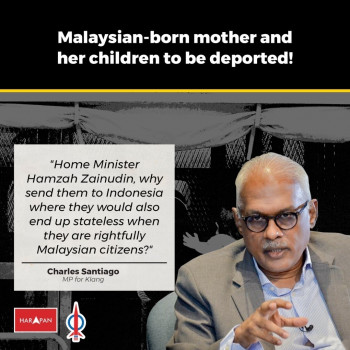By Zairil Khir Johari, DAP MP for Bukit Bendera

One of the peculiarities of our country is the longevity of the ruling regime, which has never lost a single general election since independence six decades ago. However, this sterling record has little to do with performance or popularity than it has to do with the uncanny ability of the government to continually ensure that the rules of the game are stacked in their favour.
Nowhere is this more obvious than in the constituency re-delineation exercises that have been undertaken throughout the years. As has been admitted personally by a former chairman of the Election Commission (EC), electoral boundary reviews have often been conducted with the objective of ensuring political outcomes that favour the ruling coalition.[1]
In the last general election, Barisan Nasional (BN) ended up with 60 per cent of parliamentary seats despite winning only 47 per cent of popular votes, leaving the opposition with 40 per cent of seats with 51 per cent of votes. Clearly, the wishes of the electorate were not reflected in the outcome. With the new re-delineation proposals, it has become clear that the voters’ wishes are the least of the EC’s concerns, as malapportionment looks set to be exacerbated.
Ignoring the Constitution
Even constitutional provisions are paid little heed to. Specifically, Sub-section 2(c) of the Thirteenth Schedule of the Federal Constitution expressly states that:
“(c) the number of electors within each constituency in a State ought to be approximately equal except that, having regard to the greater difficulty of reaching electors in the country districts and the other disadvantages facing rural constituencies, a measure of weightage for area ought to be given to such constituencies;”
The key corollaries from this provision are that seats within a state should be as approximately equal as possible, with a caveat for over-representation on the basis of area size. In other words, geographically large constituencies may have lesser voters compared to denser urban seats, though the limits to such discrepancies are now unclear following amendments to the Constitution in 1973 that removed a clause postulating that “in some cases a rural constituency may contain as little as one half of the electors of any urban constituency.” That said, it is reasonable to assume that area weightage between two seats, particularly within a state, should not extend to beyond two or three times, or even more, as is the case now.
Yet it would appear that the EC has completely no regard for reasonableness. A prime example of this is the case of two state seats in Penang, namely Paya Terubong and Air Putih, the former of which has increased to 41,707 voters while the latter is set to reduce to 12,752. These two seats are geographical neighbours, yet one is 3.3 times larger than the other.
At the parliamentary level, two constituencies from the same district, Bukit Gelugor and Tanjong, also suffer from highly disproportionate voter distribution. With 84,755 voters, Bukit Gelugor is the largest parliamentary constituency in Penang while Tanjong is the smallest with only 50,324. This means that Bukit Gelugor has 1.68 times more voters than Tanjong. In this case, and indeed in the case of Paya Terubong and Air Putih as well, such blatant disparities should not arise as the clause for area weightage is inapplicable when they are all urban seats with no logistical difficulties in reaching electors.
Shifting the goalposts
Clearly, the failure to redraw boundaries in order to even out the sizes of these constituencies is a dereliction of duty on the part of the EC. However, while the political impact of these cases of malapportionment in Penang may not be arguably significant enough to affect the electoral equilibrium in the state, the same cannot be said of the creative abuse of sub-section 2(c) which is taking place in Selangor.
The latest re-delineation proposals for Selangor are nothing short of drastic and patently designed to achieve devious political ends. In the changes, certain opposition-held parliamentary seats have been augmented with opposition-leaning polling districts and even whole state seats from other areas in order to form massive opposition strongholds. This also has the added effect of increasing the vulnerability of neighbouring opposition-held seats that lose their supporters.
Take for example the parliamentary seat of Petaling Jaya Utara, which the opposition won convincingly two terms in a row. In the latest re-delineation exercise, it is nearly doubled in size from 85,401 voters to 150,439. This is achieved by absorbing the entire Bukit Lanjan state seat, leaving the Subang parliamentary seat, from which Bukit Lanjan is taken, reduced in size and bereft of a huge chunk of opposition-leaning supporters. In other words, while the opposition would likely retain Petaling Jaya Utara (or its new name Damansara as suggested in the EC’s proposals) with a larger majority, Subang (or its new name Sungai Buloh) will become far easier for BN to recapture. The same trend is evident in other opposition-held constituencies as well, such as Serdang and Klang, both of which are set to increase in size and majority at the expense of their neighbours Hulu Langat and Kapar.
The intended outcome from these proposed re-delineated seats is clear. An analysis that transposes the voting patterns of the previous general election onto the new electoral configurations finds that parties from the federal opposition stand to lose seven seats in the state, with eight others becoming marginal.[2] Thus, if these proposals are accepted, then BN stands to make large gains even before the election campaign begins.
One man, one vote, no value
Such a scenario also results in gross inequality of ballot value. This means that voters in over-sized constituencies would be far more under-represented compared to those in smaller constituencies. Once again, the case of Selangor is telling. The proposed Damansara (Petaling Jaya Utara) seat with 150,439 voters would completely dwarf its Selangor counterpart, Sabak Bernam, which has only 37,126 voters. There is absolutely no rational justification to say that a difference of four times can be accepted to be “approximately equal” or an acceptable area weightage.
As a result of this malapportionment, about one and a half million voters or 13.5 per cent of the total 11.3 million registered Malaysian voters will be severely under-represented by virtue of being in 13 “super-sized” seats with more than a hundred thousand voters. Each of these seats, namely Damansara (150,439), Bangi (146,1680, Klang (141,275), Petaling Jaya (129,363), Subang (128,330), Gelang Patah (112,081), Kota Raja (121,126), Pasir Gudang (108,156), Kota Melaka (105,067), Kuala Terengganu (101,875), Sungai Petani (101,829), Tumpat (101,318) and Kapar (100,456), far eclipse the average size of parliamentary constituencies in the peninsula, which comes up to about 68,814 voters. Perhaps not so coincidentally, 12 of these 13 seats are currently held by the opposition – thus robbing opposition supporters of the value of their ballot.
No room for the meek
There are many more examples that can be cited to prove that these re-delineation proposals are nothing more than a grand scheme of electoral robbery, stealing not only seats from the opposition but also disenfranchising millions of voters of their right to equal ballot value.
Under such circumstances, there can be no room for meekness in response. Every Malaysian who believes in a democratic future for the country must exercise their right to reject the re-delineation proposals. Firstly, official objections have to be filed by all stakeholders. In cooperation with electoral watchdog Bersih 2.0 and other activists, the Selangor and Penang state governments have submitted their petitions of protest against the EC. Elected representatives and organised groups of voters have also been mobilised in these two states and throughout the country. In case these objections meet a roadblock or get turned down, then judicial review will be sought where possible.
However, as important as the official and legal processes are, there is nothing louder and more effective as a tool of protest than the collective voice of people marching on the streets. Lest we forget, the “political tsunami” of 2008 was in large part a result of the first Bersih rally in 2007 and the Hindraf demonstration soon after. There was also no doubt that the 2013 general election had been buoyed by the spirit of the masses following the Bersih 2.0 and Bersih 3.0 rallies which captured the imagination of the entire nation. Even the government could not ignore it when tens of thousands of Malaysians stood up to tear gas and water cannons to demand free and fair elections. As a result, some electoral reforms were undertaken, including the use of indelible ink to ensure that double voting does not happen.
Last year, the Bersih 4 rally saw half a million people swarming Kuala Lumpur in the greatest exercise of freedom of assembly that the country has ever seen. But the battle is far from over. The latest re-delineation proposals prove that a desperate regime will resort to any means foul or fair to ensure its survival. Do we sit by and allow them to steal our future as they have done with our taxes? Or do we once again stand up to make our voices heard?
Come 19 November, let us reclaim our country through Bersih 5.
[1] http://www.freemalaysiatoday.com/category/nation/2013/11/28/redelineation-was-to-protect-bn-not-malay-power/ [2] https://www.malaysiakini.com/news/356506


